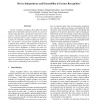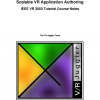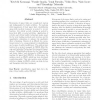VR
2003
IEEE
14 years 4 months ago
2003
IEEE
We present a demonstrated and commercially viable self-tracker, using robust software that fuses data from inertial and vision sensors. Compared to infrastructurebased trackers, s...
VR
2003
IEEE
14 years 4 months ago
2003
IEEE
The usefulness of modern day haptics equipment for virtual simulations of actual maintenance actions is examined. In an effort to categorize which areas haptic simulations may be ...
VR
2003
IEEE
14 years 4 months ago
2003
IEEE
In this paper we describe two engineering experiments designed to evaluate the effectiveness of Measurand’s ShapeTape for wearable, mobile interaction. Our initial results sugge...
VR
2003
IEEE
14 years 4 months ago
2003
IEEE
Gesture recognition techniques often suffer from being highly device-dependent and hard to extend. If a system is trained using data from a specific glove input device, that syst...
VR
2003
IEEE
14 years 4 months ago
2003
IEEE
Bone dissection is an important component of many surgical procedures. In this paper, we discuss adaptive techniques for providing real-time haptic and visual feedback during a vi...
VR
2003
IEEE
14 years 4 months ago
2003
IEEE
ICAT
2003
IEEE
14 years 4 months ago
2003
IEEE
Movements of upper limbs are complicated, various and indispensable for daily activities. For patients with impairment of their upper limb, rehabilitation along with medical treat...
ICAT
2003
IEEE
14 years 4 months ago
2003
IEEE
Virtual reality is often used to simulate environments in which the direction of up is not aligned with the normal direction of gravity or the body. How effective are these enviro...
HAPTICS
2003
IEEE
14 years 4 months ago
2003
IEEE
Haptic rendering complex objects in virtual environments is computationally intensive. In this paper we start the investigation of a new category of approach to reducing the compu...
HAPTICS
2003
IEEE
14 years 4 months ago
2003
IEEE
This study investigated cross-modal links in attention between haptics and vision. A visual change-detection task was used as a measure of visual attention. Haptic taps on the bac...



